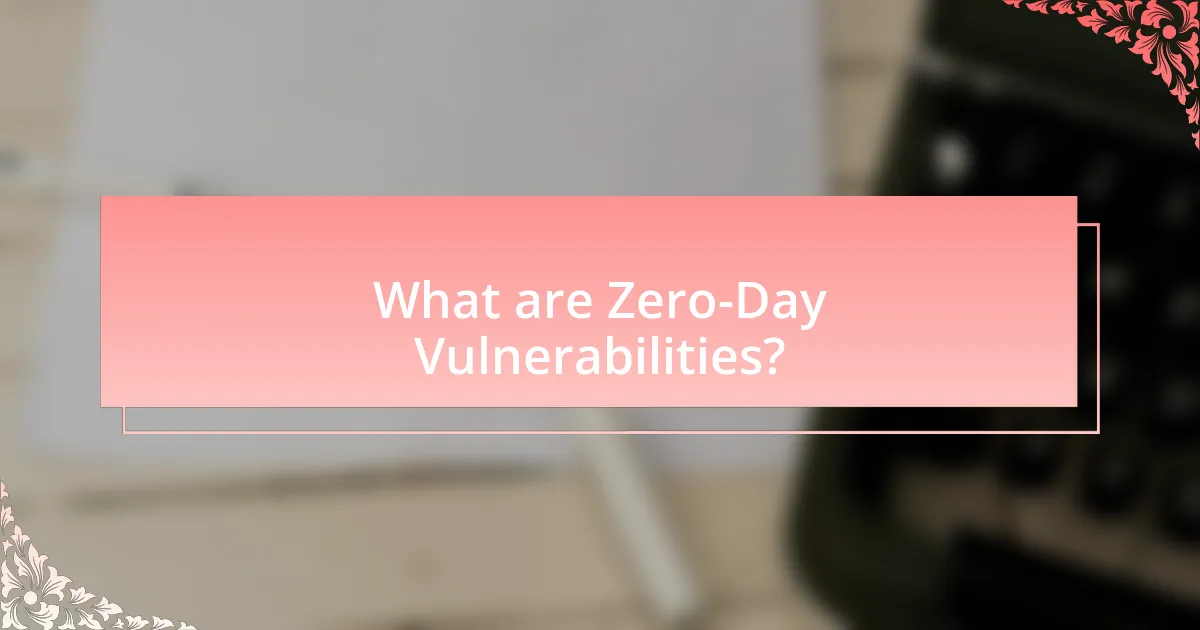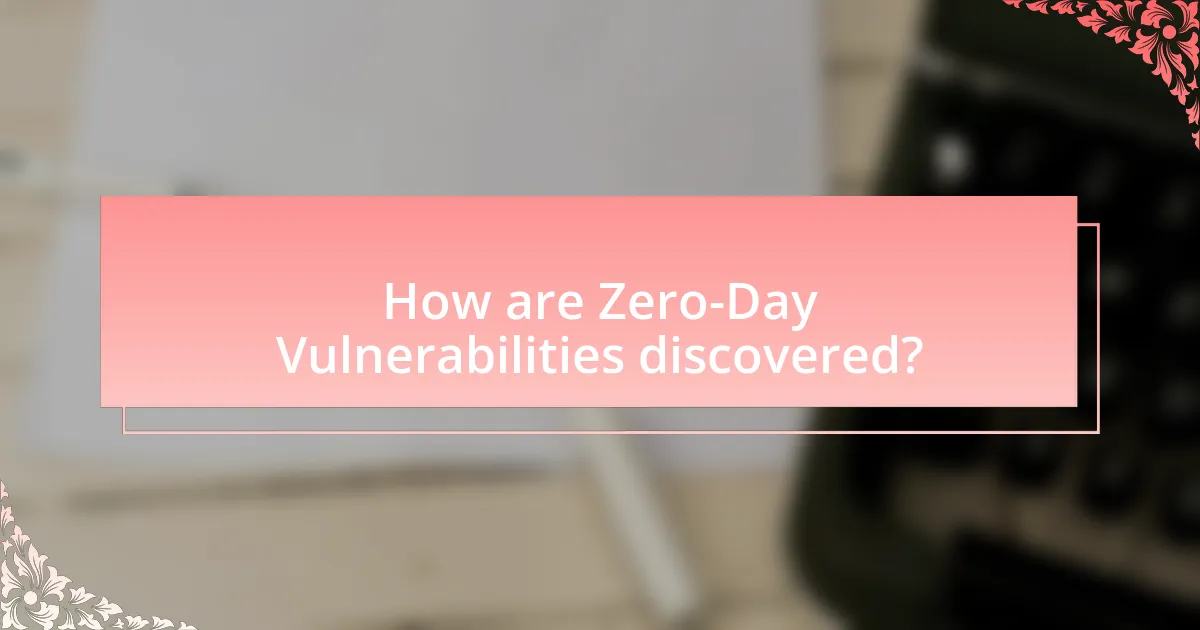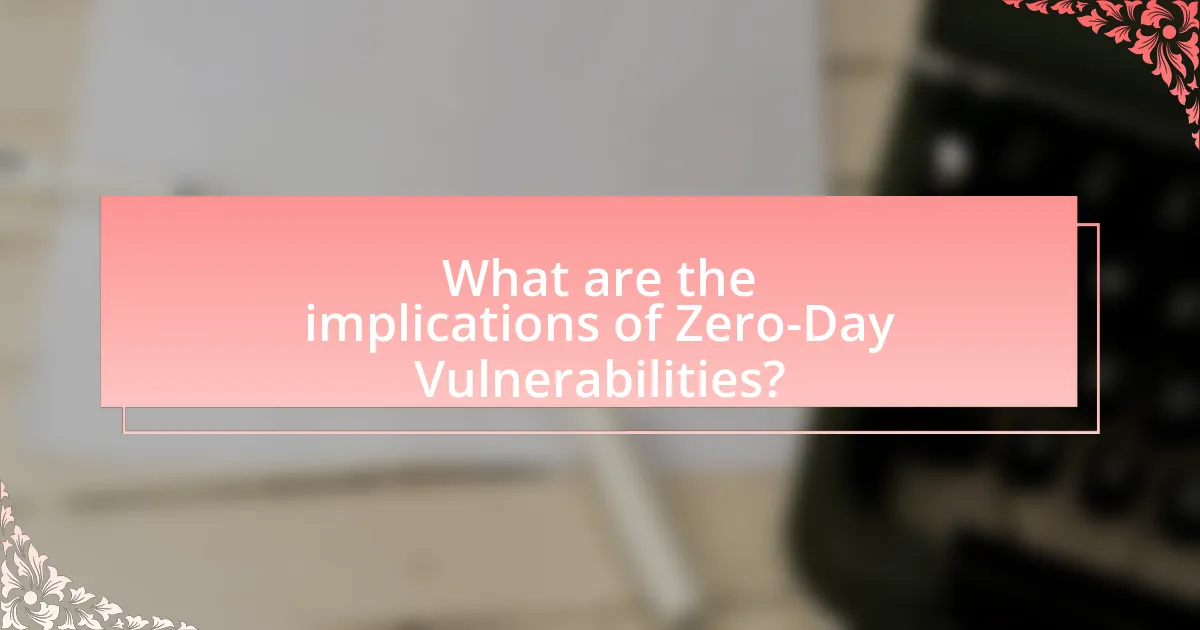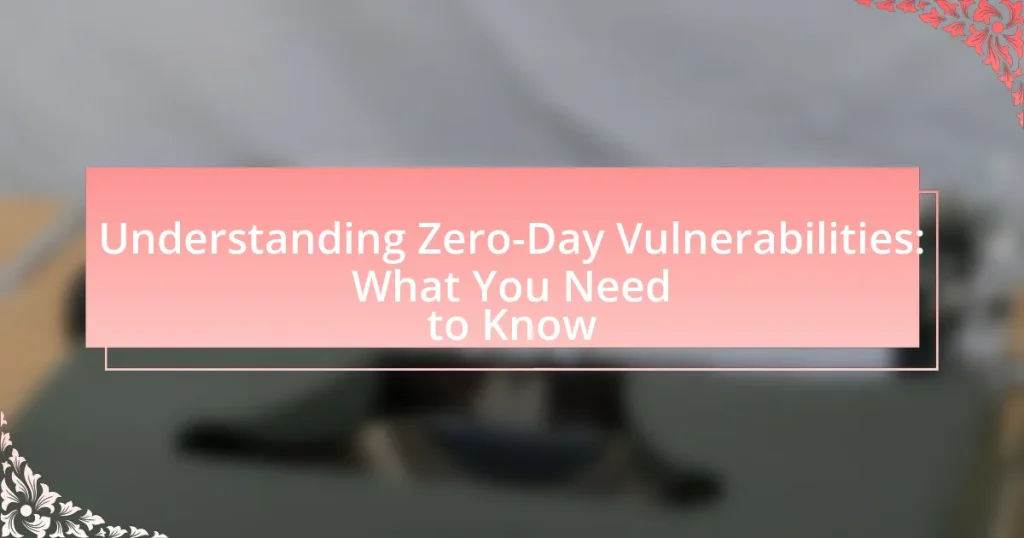Zero-day vulnerabilities are critical security flaws in software that remain unknown to the vendor and unpatched, posing significant risks to systems and networks. This article provides an in-depth examination of zero-day vulnerabilities, including their definition, how they occur, and their implications for cybersecurity. It discusses the methods used to discover these vulnerabilities, the impact they have on organizations and individuals, and the legal and ethical considerations surrounding their disclosure. Additionally, the article outlines best practices and proactive measures organizations can implement to mitigate risks associated with zero-day vulnerabilities, emphasizing the importance of timely detection and response in safeguarding against potential attacks.

What are Zero-Day Vulnerabilities?
Zero-day vulnerabilities are security flaws in software that are unknown to the vendor and have not yet been patched. These vulnerabilities are particularly dangerous because they can be exploited by attackers before the software developer has a chance to address the issue, leaving systems exposed. According to a report by the cybersecurity firm Symantec, zero-day vulnerabilities can remain unpatched for an average of 30 days, during which time they can be actively exploited in the wild.
How do Zero-Day Vulnerabilities occur?
Zero-day vulnerabilities occur when a software flaw is discovered by an attacker before the vendor has released a patch or fix. These vulnerabilities arise from coding errors, design flaws, or misconfigurations that remain unknown to the software developers. For instance, in 2020, the Microsoft Exchange Server had multiple zero-day vulnerabilities exploited by attackers before Microsoft issued a patch, highlighting how quickly these vulnerabilities can be leveraged.
What is the definition of a Zero-Day Vulnerability?
A Zero-Day Vulnerability is a security flaw in software that is unknown to the vendor and has not yet been patched. This type of vulnerability is particularly dangerous because it can be exploited by attackers before the software developer has the opportunity to address the issue, leaving systems exposed to potential attacks. The term “zero-day” refers to the fact that the developer has had zero days to fix the flaw since its discovery.
What distinguishes Zero-Day Vulnerabilities from other types of vulnerabilities?
Zero-Day Vulnerabilities are distinguished from other types of vulnerabilities by their unique characteristic of being unknown to the software vendor and lacking a patch at the time of discovery. Unlike known vulnerabilities, which have documented exploits and available fixes, Zero-Day Vulnerabilities are exploited by attackers before the vendor has the opportunity to address them, making them particularly dangerous. For instance, the 2017 Equifax breach was attributed to a Zero-Day Vulnerability in Apache Struts, which had not been patched at the time of the attack, highlighting the critical risk posed by such vulnerabilities.
Why are Zero-Day Vulnerabilities significant?
Zero-Day Vulnerabilities are significant because they represent security flaws that are exploited by attackers before the vendor has released a patch. These vulnerabilities pose a critical risk to systems and networks, as they can be used to gain unauthorized access, steal sensitive data, or disrupt services. According to a report by the Ponemon Institute, 60% of organizations experienced a zero-day attack in the past year, highlighting the urgency for timely detection and response measures. The lack of available fixes makes these vulnerabilities particularly dangerous, as they can remain undetected for extended periods, allowing attackers to exploit them freely.
What impact do Zero-Day Vulnerabilities have on cybersecurity?
Zero-Day Vulnerabilities significantly undermine cybersecurity by providing attackers with unpatched exploits to infiltrate systems before developers can respond. These vulnerabilities allow malicious actors to execute unauthorized actions, steal sensitive data, or disrupt services, often leading to substantial financial losses and reputational damage for organizations. For instance, the 2017 Equifax breach, attributed to a zero-day vulnerability, exposed personal information of approximately 147 million individuals, highlighting the severe consequences of such vulnerabilities on data security and consumer trust.
How do Zero-Day Vulnerabilities affect organizations and individuals?
Zero-day vulnerabilities significantly impact organizations and individuals by exposing them to unpatched security flaws that can be exploited by attackers. These vulnerabilities allow cybercriminals to gain unauthorized access to sensitive data, disrupt operations, and inflict financial losses. For instance, the 2017 Equifax breach, which resulted from a zero-day vulnerability, compromised the personal information of approximately 147 million people, leading to substantial reputational damage and costs exceeding $4 billion for the company. Organizations face increased risks of data breaches, operational downtime, and regulatory penalties, while individuals may suffer identity theft and financial fraud due to the exploitation of these vulnerabilities.

How are Zero-Day Vulnerabilities discovered?
Zero-day vulnerabilities are discovered through various methods, including security research, automated scanning tools, and user reports. Security researchers often analyze software for flaws, employing techniques such as fuzz testing, which involves inputting random data to identify unexpected behavior. Automated tools can scan codebases for known patterns of vulnerabilities, while users may report issues they encounter, prompting further investigation. According to a 2020 report by the Cybersecurity and Infrastructure Security Agency, approximately 60% of zero-day vulnerabilities are identified by independent researchers, highlighting the critical role of the security community in their discovery.
What methods are used to identify Zero-Day Vulnerabilities?
Methods used to identify Zero-Day Vulnerabilities include static code analysis, dynamic analysis, and fuzz testing. Static code analysis involves examining source code for potential vulnerabilities without executing the program, allowing for early detection of security flaws. Dynamic analysis tests the application in a runtime environment to identify vulnerabilities that may not be apparent in the code alone. Fuzz testing involves inputting random data into a program to uncover unexpected behaviors or crashes, which can indicate underlying vulnerabilities. These methods are validated by their widespread use in cybersecurity practices, demonstrating their effectiveness in identifying previously unknown vulnerabilities.
How do security researchers find these vulnerabilities?
Security researchers find vulnerabilities through a combination of automated tools, manual code reviews, and behavioral analysis. They utilize static and dynamic analysis tools to scan software for known vulnerabilities and weaknesses, while manual reviews allow them to identify logic flaws and security misconfigurations that automated tools may miss. Additionally, researchers often analyze the behavior of applications under various conditions to uncover unexpected vulnerabilities. This multifaceted approach is supported by historical data indicating that many vulnerabilities arise from coding errors and design flaws, which can be systematically identified through these methods.
What role do automated tools play in discovering Zero-Day Vulnerabilities?
Automated tools play a crucial role in discovering Zero-Day Vulnerabilities by enabling rapid scanning and analysis of software systems for potential security flaws. These tools utilize advanced algorithms and machine learning techniques to identify patterns and anomalies that may indicate vulnerabilities, often faster and more efficiently than manual testing methods. For instance, tools like fuzzers and static analysis software can automatically generate inputs to test software behavior, revealing weaknesses that could be exploited by attackers. The effectiveness of automated tools is supported by their ability to process vast amounts of code and data, significantly reducing the time required to detect vulnerabilities, which is essential given that Zero-Day Vulnerabilities are often exploited shortly after discovery.
What are the common sources of Zero-Day Vulnerabilities?
Common sources of Zero-Day Vulnerabilities include software bugs, misconfigurations, and unpatched software. Software bugs arise from coding errors that developers may not identify before release, leading to exploitable vulnerabilities. Misconfigurations occur when security settings are improperly set, allowing attackers to exploit weaknesses. Unpatched software refers to applications that have not been updated with the latest security fixes, leaving them open to exploitation. According to a report by the Ponemon Institute, 60% of organizations experienced a Zero-Day attack due to unpatched vulnerabilities, highlighting the critical need for timely updates and security assessments.
Which software and systems are most often affected?
Operating systems, web browsers, and enterprise software are the software and systems most often affected by zero-day vulnerabilities. For instance, Microsoft Windows and macOS frequently experience zero-day exploits due to their widespread use and complexity. Additionally, popular web browsers like Google Chrome and Mozilla Firefox are targeted because they handle numerous web applications and plugins. Enterprise software, such as Adobe products and various database management systems, also face vulnerabilities, as they are critical for business operations and often contain outdated components. According to the 2022 Verizon Data Breach Investigations Report, 82% of vulnerabilities exploited in breaches were known but unpatched, highlighting the importance of timely updates in these systems.
How do coding errors contribute to the emergence of Zero-Day Vulnerabilities?
Coding errors are a primary factor in the emergence of Zero-Day Vulnerabilities, as they create unintentional flaws in software that can be exploited by attackers before the developers are aware of them. These errors often arise from insufficient testing, misconfigurations, or overlooked edge cases, leading to security loopholes. For instance, the 2017 Equifax breach was attributed to a failure to patch a known vulnerability in the Apache Struts framework, highlighting how coding oversights can leave systems open to exploitation. Such vulnerabilities remain “zero-day” until they are discovered and patched, making them particularly dangerous in the cybersecurity landscape.

What are the implications of Zero-Day Vulnerabilities?
Zero-day vulnerabilities have significant implications for cybersecurity, as they represent unpatched security flaws that can be exploited by attackers before the vendor releases a fix. These vulnerabilities can lead to unauthorized access, data breaches, and system compromises, resulting in financial losses and reputational damage for organizations. For instance, the 2017 Equifax breach, which exposed sensitive information of approximately 147 million people, was partly due to a zero-day vulnerability in Apache Struts. This incident highlights the critical need for timely patch management and proactive security measures to mitigate the risks associated with zero-day vulnerabilities.
How do Zero-Day Vulnerabilities impact cybersecurity strategies?
Zero-day vulnerabilities significantly impact cybersecurity strategies by creating urgent challenges for organizations to defend against unknown threats. These vulnerabilities are flaws in software that are exploited by attackers before the vendor has released a fix, leaving systems exposed. According to a report by the Ponemon Institute, 60% of organizations experienced a zero-day attack in the past year, highlighting the necessity for proactive measures. Consequently, cybersecurity strategies must prioritize real-time threat detection, continuous monitoring, and rapid incident response to mitigate the risks associated with these vulnerabilities. This shift in strategy is essential for maintaining security in an evolving threat landscape.
What measures can organizations take to mitigate risks associated with Zero-Day Vulnerabilities?
Organizations can mitigate risks associated with Zero-Day Vulnerabilities by implementing a multi-layered security approach that includes regular software updates, robust intrusion detection systems, and employee training on cybersecurity awareness. Regular software updates ensure that known vulnerabilities are patched promptly, reducing the window of opportunity for exploitation. Intrusion detection systems can identify unusual behavior indicative of an attack, allowing for swift response. Additionally, training employees to recognize phishing attempts and other social engineering tactics can prevent initial breaches that might exploit Zero-Day vulnerabilities. According to a report by the Ponemon Institute, organizations that invest in employee training can reduce the risk of breaches by up to 70%.
How do Zero-Day Vulnerabilities influence the development of security patches?
Zero-day vulnerabilities significantly accelerate the development of security patches as they represent unaddressed security flaws that can be exploited by attackers. When a zero-day vulnerability is discovered, software developers prioritize creating a patch to mitigate the risk of exploitation, often leading to expedited testing and deployment processes. For instance, in 2020, the Microsoft Exchange Server zero-day vulnerabilities prompted the company to release emergency patches within days of discovery to protect users from widespread attacks. This urgency in patch development is driven by the potential for severe consequences, including data breaches and financial losses, which necessitate immediate action to safeguard systems.
What are the legal and ethical considerations surrounding Zero-Day Vulnerabilities?
Legal and ethical considerations surrounding Zero-Day Vulnerabilities include issues of responsibility, disclosure, and the potential for exploitation. Legally, the unauthorized use or distribution of Zero-Day vulnerabilities can violate laws such as the Computer Fraud and Abuse Act in the United States, which prohibits unauthorized access to computer systems. Ethically, researchers face dilemmas regarding whether to disclose vulnerabilities to the public or to the affected vendors first, balancing the need for security against the risk of exploitation by malicious actors. The ethical principle of “responsible disclosure” advocates for notifying the vendor and allowing time for a fix before public disclosure, which is supported by organizations like the Internet Engineering Task Force.
What responsibilities do researchers have when discovering Zero-Day Vulnerabilities?
Researchers have the responsibility to responsibly disclose Zero-Day Vulnerabilities to the affected vendors or organizations. This process involves notifying the vendor about the vulnerability, allowing them time to develop and release a patch before the information is made public. According to the “Responsible Disclosure” guidelines established by organizations like the Internet Engineering Task Force (IETF), researchers should provide sufficient details for the vendor to understand and address the issue while maintaining the confidentiality of the vulnerability until a fix is available. This approach minimizes the risk of exploitation and protects users from potential harm.
How do laws vary regarding the disclosure of Zero-Day Vulnerabilities?
Laws regarding the disclosure of Zero-Day Vulnerabilities vary significantly across jurisdictions. In the United States, the Computer Fraud and Abuse Act (CFAA) can impose legal risks on researchers who disclose vulnerabilities without permission from the affected parties, while the European Union’s General Data Protection Regulation (GDPR) emphasizes the need for responsible disclosure to protect personal data. Additionally, some countries have specific laws that encourage responsible disclosure, such as the UK’s Computer Misuse Act, which has been interpreted to allow for ethical hacking under certain conditions. These variations reflect differing legal frameworks and cultural attitudes toward cybersecurity and privacy, impacting how vulnerabilities are reported and managed globally.
What best practices can help protect against Zero-Day Vulnerabilities?
To protect against Zero-Day Vulnerabilities, organizations should implement a multi-layered security approach that includes regular software updates, robust intrusion detection systems, and employee training on security awareness. Regular software updates ensure that known vulnerabilities are patched promptly, reducing the risk of exploitation. Intrusion detection systems can identify unusual behavior indicative of an attack, allowing for swift response. Employee training enhances awareness of phishing and social engineering tactics, which are often used to exploit vulnerabilities. According to a report by the Ponemon Institute, organizations that adopt a proactive security posture can reduce the risk of breaches by up to 50%.
How can organizations implement proactive security measures?
Organizations can implement proactive security measures by conducting regular vulnerability assessments and penetration testing to identify and mitigate potential threats. These assessments help organizations understand their security posture and address weaknesses before they can be exploited. According to a report by the Ponemon Institute, organizations that conduct regular vulnerability assessments reduce their risk of a data breach by 50%. Additionally, implementing a robust patch management process ensures that software vulnerabilities are addressed promptly, minimizing the window of exposure to zero-day attacks. Regular employee training on security best practices further enhances an organization’s ability to prevent security incidents.
What role does employee training play in preventing exploitation of Zero-Day Vulnerabilities?
Employee training plays a critical role in preventing the exploitation of Zero-Day Vulnerabilities by equipping staff with the knowledge and skills to recognize and respond to potential threats. Trained employees are more likely to identify suspicious activities, adhere to security protocols, and implement best practices for software updates and patch management. Research indicates that organizations with comprehensive security training programs experience 70% fewer security incidents, highlighting the effectiveness of training in enhancing overall cybersecurity posture. By fostering a culture of security awareness, employee training significantly reduces the risk of successful exploitation of Zero-Day Vulnerabilities.


